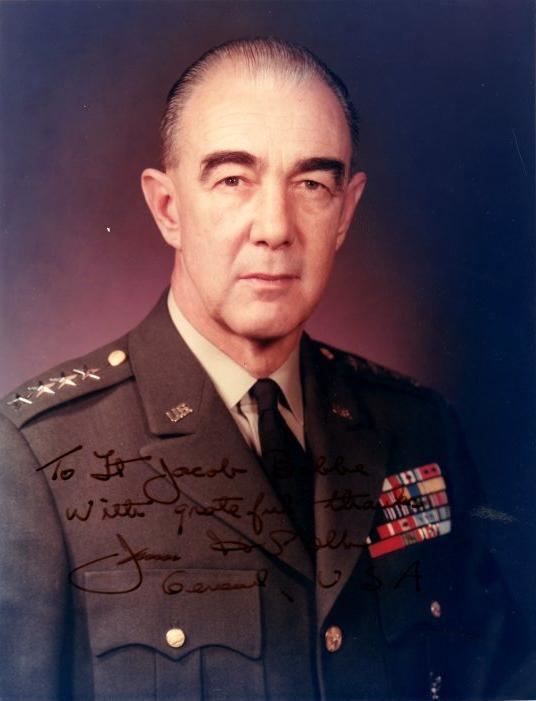Allegiance United States Name James Polk | Years of service 1933–1971 | |
 | ||
Commands held U.S. Army Europe4th Armored Division People also search for Arthur W. Radford, Edward A. Craig, Joseph Stalin | ||
1971 mercedes 250c owned by james h polk 4 star general in the us army
James Hilliard Polk (December 13, 1911 – February 18, 1992) was a United States Army four-star general who served as Commander in Chief, United States Army Europe from 1967 to 1971. He was one of the last senior commanders in the army to have served in the horse cavalry.
Contents
- 1971 mercedes 250c owned by james h polk 4 star general in the us army
- Military career
- Decorations
- Post military career
- References
Military career
Polk was born at Camp McGraw in Batangas in the Philippines on December 13, 1911 to Colonel Harding Polk, and the former Esther Fleming. He graduated from the United States Military Academy in 1933 and was commissioned in the cavalry. Prior to World War II he served in two cavalry regiments, and attended the basic and advanced courses at the cavalry school. In 1939 at the National Horse Show at Madison Square Garden he won first place in the Individual Military and Police Jumping event.
At the outbreak of World War II he was assigned to West Point as a tactical officer. In 1943 he attended a shortened general staff course at Fort Leavenworth, and after graduation joined the 106th Cavalry Group at Camp Hood, Texas as a squadron commander, and later as regimental executive officer. In Europe, the group fought in the hedgerows of Normandy and the breakout from Saint-Lô.
In early September 1944, Polk assumed command of the 3rd Cavalry Group, then in combat near Metz, France, and commanded it until the end of the war. During this time the unit was known as "Task Force Polk", and spearheaded many advances by Gen. Walton Walker's XX Corps, part of Gen. George S. Patton, Jr.'s Third Army.
After brief occupation duty in Germany at the end of World War II, Polk returned to the U.S. and became Chief of Tactics at the Ground General School at Fort Riley, Kansas, and later attended the Armed Forces Staff College. In 1948 he went to Tokyo in the G-2 (Intelligence) section of the U.S. Far East Command for the next three years.
During the Korean War Polk was assigned as G-2 to Gen. Ned Almond's X Corps and later as G-2 to Gen. James Van Fleet's 8th Army, and participated in three campaigns. In August 1951 he returned stateside to attend the National War College, and was later assigned as an instructor at the Army War College. He was then made Chief of Staff of the 3rd Armored Division at Fort Knox, participating in their move to Germany. In July 1956 he was promoted to Brigadier General and became assistant division commander.
Following an assignment as Assistant Chief of Staff for Plans and Operations, Land Forces Central Europe at NATO Headquarters at Fontainebleau under General Dr. Hans Speidel, Polk returned to the U.S. and became Director of the Policy Planning Staff in the Office of the Assistant Secretary of Defense for International Security Affairs.
Upon promotion to Major General, Polk took command of the 4th Armored Division, followed by being the U.S. commandant in Berlin from January 2, 1963 to August 31, 1964 during a time of increased Cold War tensions and President John F. Kennedy's visit to Berlin in June, 1963.
Polk became commander of V Corps on September 1, 1964, and in 1966 returned to CONUS to become Assistant Chief of Staff for Force Development. He returned to Europe at the end of that year, first as Deputy Commander in Chief, U.S. Army Europe, and six months later was promoted to four-star General as Commander in Chief, U.S. Army Europe. He retired from active duty on April 1, 1971.
Decorations
Polk's awards and decorations included the Army Distinguished Service Medal, the Legion of Merit, the Silver Star with Oak Leaf Cluster, the Bronze Star, the French Croix de guerre, the French Legion of Honor, the American Campaign Medal, the Air Medal, and the Korean Presidential Unit Citation, the World War II Victory Medal, the European-African-Middle Eastern Theater Medal.
Post military career
Polk retired to El Paso, Texas, and served as Chairman of the Board of the U.S. Cavalry Association from 1978 to 1992, and President of Army Emergency Relief from 1975 to 1984. He died on February 18, 1992 at William Beaumont Army Medical Center in El Paso, Texas after battling cancer and pneumonia. He was buried in Arlington National Cemetery, and later his wife, Josephine Leavell Polk (1913–1999), was buried with him. His World War II letters were published in 2005 under the title World War II Letters and Notes of Colonel James H. Polk, 1944–1945 (ISBN 1932762191). The 3d Cavalry Association has named its scholarship fund for the children of fallen 3ACR soldiers after him.
